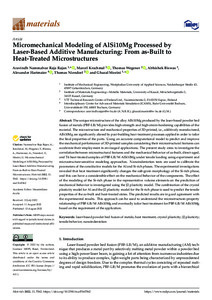Micromechanical Modeling of AlSi10Mg Processed by Laser-Based Additive Manufacturing: From as-Built to Heat-Treated Microstructures
| dc.date.accessioned | 2023-08-10T08:19:37Z | |
| dc.date.available | 2023-08-10T08:19:37Z | |
| dc.date.issued | 2022-08-13 | |
| dc.identifier | doi:10.17170/kobra-202308108594 | |
| dc.identifier.uri | http://hdl.handle.net/123456789/14979 | |
| dc.language.iso | eng | |
| dc.rights | Namensnennung 4.0 International | * |
| dc.rights.uri | http://creativecommons.org/licenses/by/4.0/ | * |
| dc.subject | laser-based powder bed fusion of metals | eng |
| dc.subject | heat treatment | eng |
| dc.subject | crystal plasticity | eng |
| dc.subject | J2 plasticity | eng |
| dc.subject | tensile behavior | eng |
| dc.subject | nanoindentation | eng |
| dc.subject.ddc | 600 | |
| dc.title | Micromechanical Modeling of AlSi10Mg Processed by Laser-Based Additive Manufacturing: From as-Built to Heat-Treated Microstructures | eng |
| dc.type | Aufsatz | |
| dcterms.abstract | The unique microstructure of the alloy AlSi10Mg produced by the laser-based powder bed fusion of metals (PBF-LB/M) provides high-strength and high-strain-hardening capabilities of the material. The microstructure and mechanical properties of 3D-printed, i.e., additively manufactured, AlSi10Mg are significantly altered by post-building heat-treatment processes applied in order to tailor the final properties of the parts. Using an accurate computational model to predict and improve the mechanical performance of 3D-printed samples considering their microstructural features can accelerate their employment in envisaged applications. The present study aims to investigate the correlation between microstructural features and the mechanical behavior of as-built, direct-aged, and T6 heat-treated samples of PBF-LB/M AlSi10Mg under tensile loading using experiment and microstructure-sensitive modeling approaches. Nanoindentation tests are used to calibrate the parameters of the constitutive models for the Al and Si-rich phases. The experimental investigations revealed that heat treatment significantly changes the sub-grain morphology of the Si-rich phase, and this can have a considerable effect on the mechanical behavior of the components. The effect of the modeling of the Si-rich phase in the representative volume elements on the prediction of mechanical behavior is investigated using the J2 plasticity model. The combination of the crystal plasticity model for Al and the J2 plasticity model for the Si-rich phase is used to predict the tensile properties of the as-built and heat-treated states. The predicted results are in good agreement with the experimental results. This approach can be used to understand the microstructure–property relationship of PBF-LB/M AlSi10Mg and eventually tailor heat treatment for PBF-LB/M AlSi10Mg based on the requirement of the application. | eng |
| dcterms.accessRights | open access | |
| dcterms.creator | Nammalvar Raja Rajan, Aravindh | |
| dcterms.creator | Krochmal, Marcel | |
| dcterms.creator | Wegener, Thomas | |
| dcterms.creator | Biswas, Abhishek | |
| dcterms.creator | Hartmeier, Alexander | |
| dcterms.creator | Niendorf, Thomas | |
| dcterms.creator | Moeini, Ghazal | |
| dcterms.extent | 23 Seiten | |
| dc.relation.doi | doi:10.3390/ma15165562 | |
| dc.subject.swd | Wärmebehandlung | ger |
| dc.subject.swd | Plastizität | ger |
| dc.subject.swd | Legierung | ger |
| dc.type.version | publishedVersion | |
| dcterms.source.identifier | eissn:1996-1944 | |
| dcterms.source.issue | Issue 16 | |
| dcterms.source.journal | Materials | eng |
| dcterms.source.volume | Volume 15 | |
| kup.iskup | false | |
| dcterms.source.articlenumber | 5562 |
Dateien zu dieser Ressource
Das Dokument erscheint in:
-
Publikationen [75]


